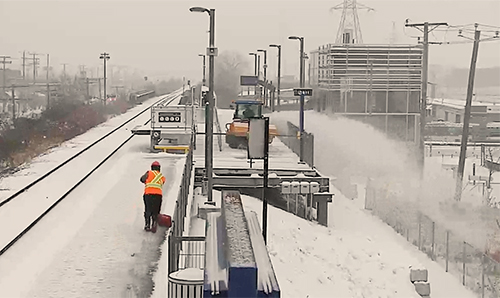Snow removal: winter site maintenance

Snow removal 101
To ensure your safety, our facilities are cleared of snow, de-iced, and spread with abrasives (salt, sand, gravel, ice melters) as soon as:
- Snow accumulation reaches 5 cm
- The yellow line on the platforms is no longer visible
- Bus loops are covered in snow
Good to know
Abrasive spreading operations are rarely performed during peak periods. Why? Because they could lengthen embarking and disembarking times, resulting in delays.
Which areas are maintained?
Snow removal operations cover all pedestrian and vehicle traffic areas.
Pedestrian traffic areas
- Access stairs
- Fire escapes
- Access ramps for persons with reduced mobility
- Sidewalks
- Train station platforms
- Bus terminal platforms
- Transit shelters
Vehicle traffic areas
- Traffic lanes
- Parking lots
- Bus loops
Good to know
In winter, sign visibility on the ground may be reduced. However, please try to respect them when parking. That way, you will help snow removers carry out their operations as well as protect your vehicle.
Which abrasives are used on which surfaces?
Salt, sand and gravel are regularly spread throughout our sites, with the exception of station platforms. As salt damages both the metal elements at the edge of the platform and the escalators, and sand and gravel can block doors from closing, we instead use magnesium chloride (MgCl2), which melts the snow when it falls.
Snow removal strategy for freezing rain
When both snow and freezing rain are forecast, the snow removers deliberately choose not to remove all of the snow. This allows the freezing rain to stick to the snow and form a layer of ice that cracks beneath your feet.
Want to learn more about exo’s winter initiatives? Read the news on our winter plan.
